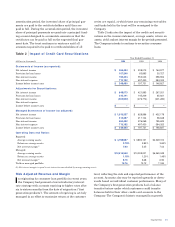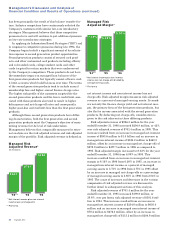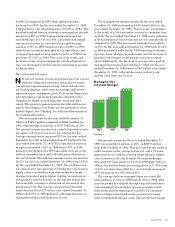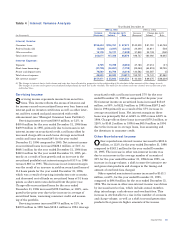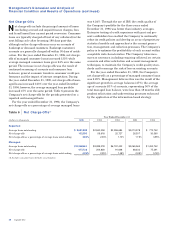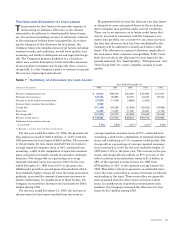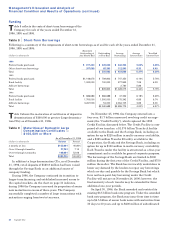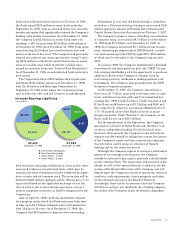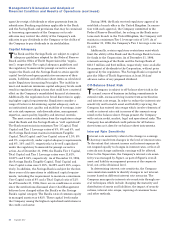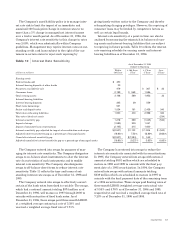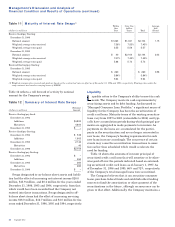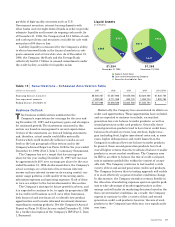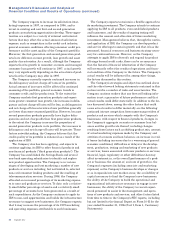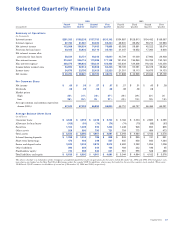Capital One 1996 Annual Report Download - page 33
Download and view the complete annual report
Please find page 33 of the 1996 Capital One annual report below. You can navigate through the pages in the report by either clicking on the pages listed below, or by using the keyword search tool below to find specific information within the annual report.
Capital One 31
bank notes with maturities from five to 30 years. In 1996,
the Bank issued $200 million in senior bank notes due
September 15, 2006, with an attached three-year, one-time
investor put option that significantly reduced the Company’s
funding costs on this transaction. As of December 31, 1996,
the Company had $3.6 billion in senior bank notes out-
standing, a 43% increase from $2.5 billion outstanding as
of December 31, 1995. As of December 31, 1996, bank notes
issued totaling $2.9 billion have fixed interest rates and
mature from one to five years. The Company had previously
entered into interest rate swap agreements (“swaps”) total-
ing $974 million to effectively convert fixed rates on senior
notes to variable rates which match the variable rates
earned on consumer loans (see “Interest Rate Sensitivity”).
As of December 31, 1996, no subordinated bank notes have
been issued.
The Corporation filed a $200 million shelf registration
statement ($125 million issued as of December 31, 1996)
with the Securities and Exchange Commission on
September 19, 1996 under which the Corporation from
time to time may offer and sell (i) senior or subordinated
debt securities consisting of debentures, notes and/or other
unsecured evidences, (ii) preferred stock, which may be
issued in the form of depository shares evidenced by depos-
itory receipts and (iii) common stock. The securities will be
limited to $200 million aggregate public offering price or its
equivalent (based on the applicable exchange rate at the
time of sale) in one or more foreign currencies, currency
units or composite currencies as shall be designated by the
Corporation.
Also on April 30, 1996, the Bank established a deposit
note program under which the Bank may issue from time
to time up to $2.0 billion of deposit notes with maturities
from 30 days to 30 years. As of December 31, 1996, the
Company had $300 million in deposit notes outstanding.
Subsequent to year-end, the Bank through a subsidiary
created as a Delaware statutory business trust issued $100
million aggregate amount of Floating Rate Subordinated
Capital Income Securities that mature on February 1, 2027.
The Company’s primary source of funding, securitization
of consumer loans, increased to $8.5 billion as of December
31, 1996 from $7.5 billion as of December 31, 1995. In
1996, the Company securitized $2.7 billion in four transac-
tions, consisting predominantly of LIBOR-based, variable-
rate deals maturing from 1997 through 2001, $500 million
of which may be extended at the Company’s option until
2004.
In January 1996, the Company implemented a dividend
reinvestment and stock purchase plan (the “DRIP”) to pro-
vide existing stockholders with the opportunity to purchase
additional shares of the Company’s common stock by
reinvesting quarterly dividends or making optional cash
investments. The Company uses proceeds from the DRIP
for general corporate purposes.
On November 17, 1995, the Company entered into a
three-year, $1.7 billion unsecured revolving credit arrange-
ment, with three tranches (A,B and C) of committed bor-
rowings (the “1995 Credit Facility”). Under tranches A and
B, the Bank could borrow up to $1.3 billion and $200 mil-
lion, respectively, subject to an unused commitment fee of
.17%. Tranche B allowed the Bank to borrow in major
foreign currencies. Under Tranche C, the Company or the
Bank could borrow up to $215 million.
For the periods prior to the Separation, the Company
operated as a division of Signet Bank and, therefore, had
no direct, independent funding. For the financial state-
ments for these periods, the Company’s reported interest
expense was determined by taking into account the nature
of the Company’s assets and their interest rate repricing
characteristics and by using an allocation of Signet’s
funding cost for the respective period.
Although the Company expects to reinvest a substantial
portion of its earnings in its business, the Company
intends to continue to pay regular quarterly cash dividends
on the Common Stock. The declaration and payment of div-
idends, as well as the amount thereof, is subject to the dis-
cretion of the Board of Directors of the Company and will
depend upon the Company’s results of operations, financial
condition, cash requirements, future prospects and other
factors deemed relevant by the Board of Directors.
Accordingly, there can be no assurance that the Company
will declare and pay any dividends. As a holding company,
the ability of the Company to pay dividends is dependent
$415
$2,077
Interest-Bearing Liabilities
(in millions)
$3,998
December 31,1995
$5,468
December 31,1996
$810
$696
$1,378
$2,616
$531
$943
■ Interest-bearing Deposits
■ Short-term Borrowings
■ Senior Notes < 3 years
■ Senior Notes > 3 years


